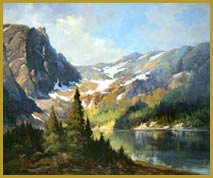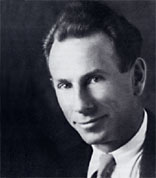|
|
|
|
|
|
|
|
|
|
Robert
W. Wood seems to have first painted the lower Rockies in the 1930s,
as the earliest paintings of the Colorado Rockies that we have discovered
date from this period. We know that he spent periods in Bartletsville,
Oklahoma in the early 1930s and again in the early 1940s, and it
seems logical that he ventured into the lower Rocky Mountains on
sketching trips. The majority of Wood's paintings of Colorado and
Utah are dated from 1941 to 1945, during World War II. This was
the only period of his long career that he seems to have consistently
dated his paintings.
While
most of Robert Wood's paintings of the Colorado Rockies feature
picturesque views, usually looking across a mountain lake at a typical
alpine scene, he also painted a number of less conventional compositions.
These are often painted high in the mountains, probably well off
the road, with a distant landmark such as Mt. Moran, Mt. Evans or
the famed Mountain of the Holy Cross far in the distance. In these
compositions the foreground detail usually consists of sparse vegetation
and rocky outcroppings, as the paintings were often done at or above
the tree line. Depictions of the southern Rockies were a very small
part of Wood's artistic production after he moved to California,
when he seemed to concentrate on the northern part of the American
Rockies, in the area around Jackson Hole, Wyoming.
|
|



